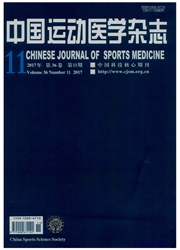

 中文摘要:
中文摘要:
目的:通过对线粒体基因(mtDNA)高变区Ⅱ(HVR-Ⅱ)作序列多态性分析,探讨与人类运动能力相关的基因标记及其分子机制.方法:受试者均为中国汉人,其中皮划艇运动员123人,举重运动员70人,对照组132人.通过特异性扩增mtDNA HVR-Ⅱ片段并测序,分析其序列多态性变化.结果与结论:中国皮划艇、举重运动员和普通汉人对照的mtDNA HVR-Ⅱ具有很高序列多样性,遗传变异性大,遗传多样性丰富.3组人群mtDNA HVR-Ⅱ同质性序列多态性无显著性差异,并具有共同特征:(1)碱基替换频率高于重排频率,碱基替换以转换为主,碱基转换中以嘌呤转换为主,嘌呤转换中以A-G频率最高;(2)重排以碱基插入为主,其中插入C频率最高,其次为CC;(3)3组人群mtDNA HVR-Ⅱ与HVR-Ⅰ具有相似的碱基替换频率.在HVR-Ⅱ中,np73位点的A-G多态性频率具有明显的种族和地域差异.
 英文摘要:
英文摘要:
Objective To investigate the association between gene markers and human athletic performance and their molecular mechanism. Methods All subjects were Han nationality, including 123 canoe athletes, 70 weightlifters and 132 normal controls. Sequence polymorphisms of mitoehondrial DNA hypervariable region Ⅱ(mtDNA HVR -Ⅱ) was determined by polymeras chain reaction (PCR) and direct sequencing. Results and Conclusions High level of mtDNA HVR-Ⅱ sequence diversities were found among all groups. Common fea- tures of homoplasmic sequence polymorphisms of all groups were revealed: 1. The frequency of nucleotide substitution was higher than nucleotide rearrangement; the frequency of transition was the highest in nucleotide substitution; the frequency of purine transition was the highest in transition ; the frequency of A - G transition was the highest in purine transition; 2. Insertion was the main change of nucleotide rearrangement, in which the frequency of insert C was the highest and secondary was insert CC; 3. There was no significant difference between the nucleotide substitution of mtDNA HVR -Ⅱ and HVR - Ⅰ among three groups. In addition, the A- G transition frequencies at np73 showed significant difference among races and/or regions.
 同期刊论文项目
同期刊论文项目
 同项目期刊论文
同项目期刊论文
 期刊信息
期刊信息
